Today, people are no longer buying products, but the stories and characters associated with the products.
Translation: DeepTechFlow
Today's story is a continuation of the past few stories. In my previous issue, I mentioned People, Not Decks, emphasizing the role of founders in determining the outcome of the company.
Today's story focuses on the users. I will explore how a company nurtures its community over a decade and why founders should pay attention to their community for scalability.
This is a prelude to an article we collaborated with several Chief Marketing Officers (CMOs). Over the next month, I will be interviewing senior executives of multiple protocols to understand how they have built their communities. My goal is to build a series of stories to guide founders in building their companies.
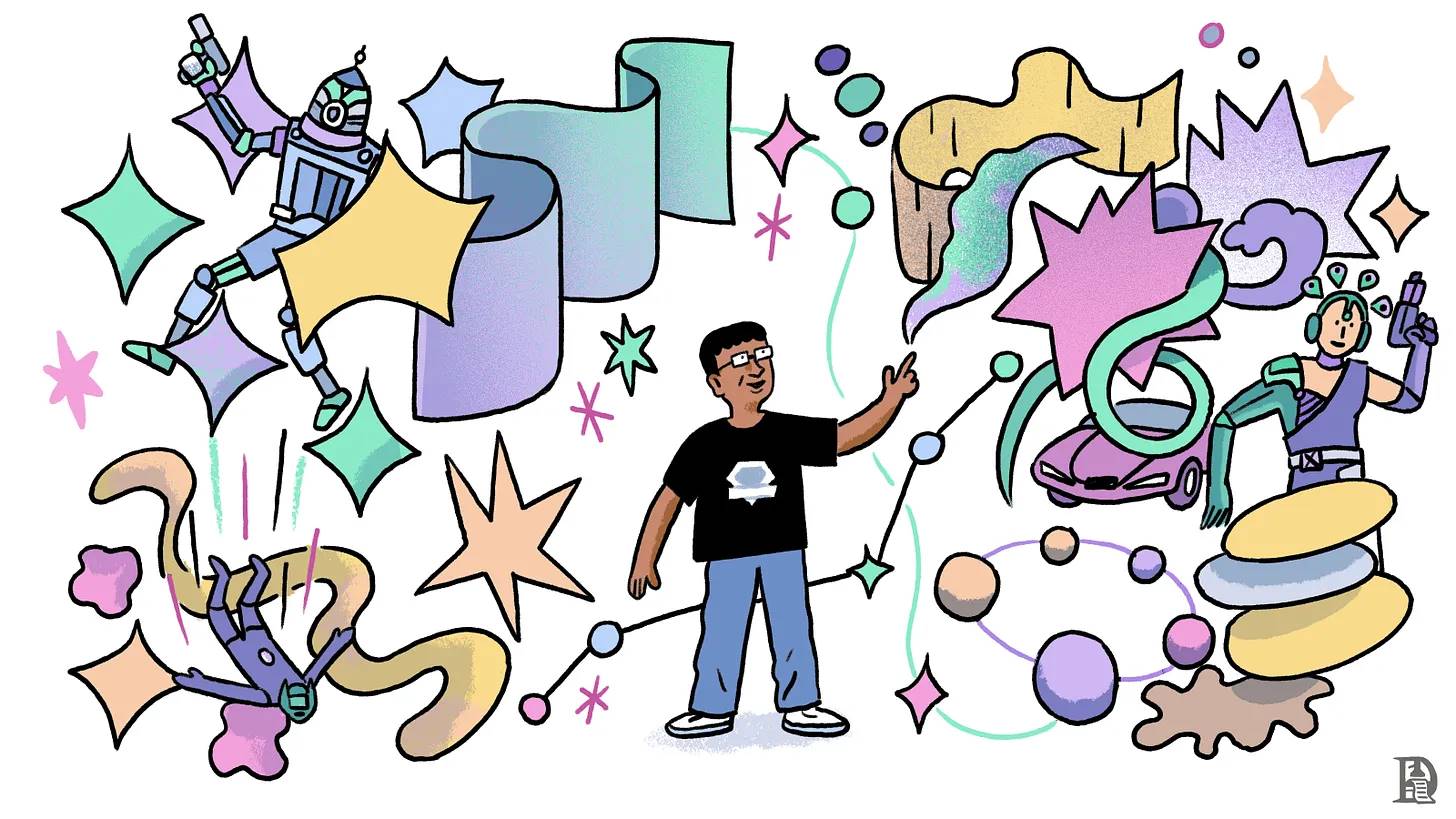
A few weeks ago, I flew back to my hometown of Pune, India. It is a hub for many tech companies. Away from the heat of Dubai, I felt very comfortable in the monsoon there. But the reason I went there was not for the natural beauty.
I left the office with a simple purpose. I went to the office of SuperGaming. We have been advising SuperGaming for over a year. They are one of the largest game publishers in the region, with over 100 million active downloads and over 20 games, five of which have over 10 million downloads. Their understanding of the metaverse goes beyond our imagination.
I have been following their CEO Roby John and admire his approach to building a community. Whenever we talk about the product, he always elaborates on how they leverage the community to support what they are building. They have no tokens or protocols, just many beloved games.
So, I spent two days at their office, during which we discussed his journey as a founder while eating samosas and drinking hot filter coffee. We discussed the conditions required to build a large-scale community and why these communities are important. This is a summary of Roby's over ten years of experience, condensed into a few thousand words.
For the busy readers, the main points of this article are as follows. I will break down how to build a community at each stage.
I explain why, at the seed stage, you should operate under a more well-known and recognizable banner.
We explore how communicating with users and making them feel heard and valued can have a huge impact when scaling.
I also explain why "culture" is the ultimate challenge that companies must face in their growth process.
Don't worry, I won't leave you with abstract references. In the next 15 minutes, we will review Roby's 15 years of experience in building a company together.
Getting Started
- A young, idealistic founder from India entered YCombinator. He was no stranger to the world of startups. At the age of 21, he signed a million-dollar consulting contract during the dot-com bubble, but the process of creating something new was exciting. Roby was developing a game to help users better understand mathematics. They were specifically developing for the upcoming iOS devices, especially the iPad app.
There wasn't much success in the early stages, but he soon noticed that some young users were posting videos of his product on YouTube.
This gave Roby an epiphany. This was the period when the founders of Airbnb flew to New York to shoot user listings. User-uploaded images were often not attractive enough, so the founders made efforts to personally shoot for the hosts. This personalized the onboarding process for hosts and made users supporters of trust. Roby was inspired by this.
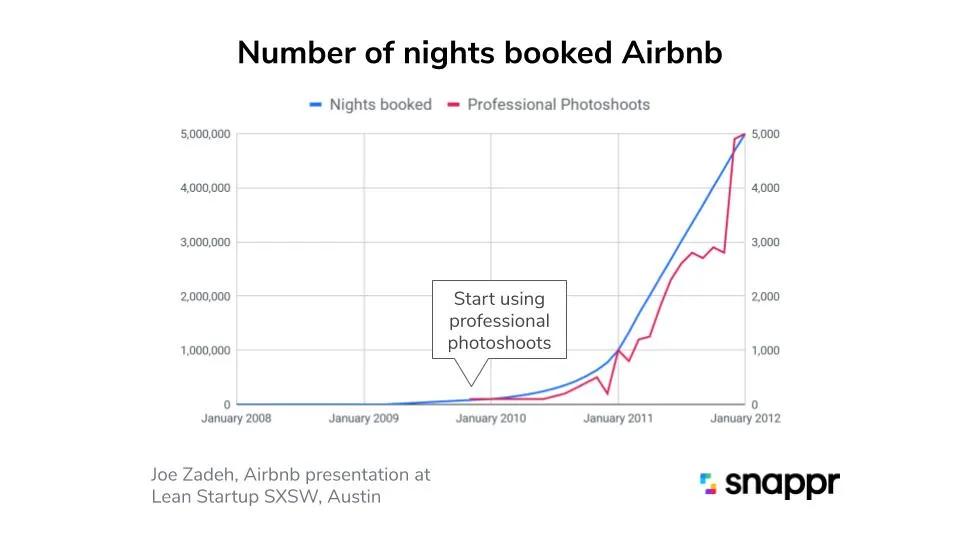
The above image is from Snappr's blog. This phenomenon is further detailed in this study.
He realized that empowering users to spread his product would be the key between its relevance and rapid death, so his focus naturally shifted to building a community.
If you are a small studio from India, the chances of immediate recognition are slim. This was before the widespread adoption of smartphones and internet access globally. The gaming industry at that time was very similar to cryptocurrency today, with many prejudices against people working in gaming.
So, how do you build a convincing brand?
One way is to act under a more well-known name.
Recognition
In 2012, Roby and his team raised a million dollars in seed funding for the company then known as June Software (which eventually merged with Super). Investors included the then well-known publisher Backflip Studios. Their collaboration opened up opportunities for Roby to work with many beloved intellectual properties (IP) at the time. It can be understood that users may not specifically search for the name of a game studio.
For example, few people may recognize Rockstar Games, but children often search for "Spider-Man" and other words in hopes of playing games related to their favorite characters. We also saw this when working with Niantic on the successful case of building augmented reality (AR) with Pokemon GO. Studios often use excellent IP for user discovery.
So, Roby began collaborating with Backflip to develop games like NinJump at very low cost to acquire users. In the early days, this collaboration helped users discover the games being created by June Software. More importantly, it allowed Roby to understand how game studios operate. He gained expertise in discovery and operations in one move.
Even today, Super's platform supports Pac-Man globally through a partnership with Bandai Namco, the publisher of other works such as "Elden Ring," "Tekken," and "Dragon Ball." They joined SuperGaming as investors in 2023.
Similar situations have occurred in blockchain protocols as well. Joining Polygon in 2021 meant access to a wider range of DeFi products migrated to that chain. Building on Solana in 2024 meant access to users exploring meme assets. Or on Base, you could reach consumer products.
Currently, a similar situation is emerging as founders launch AVS on EigenLayer. The combination of a large brand and operational expertise drives growth when incentives are aligned.
Operating under a larger banner requires founders to go beyond their capabilities. Large protocols (or brands) do not need to collaborate with startups unless they can surpass execution and meet consumer needs. In large companies, small and efficient teams often avoid failures caused by committee decisions. If you are a founder building for a larger brand, consider being prepared with concept validation or research results to support your claims.
SuperGaming achieved this goal by focusing on core strengths. By 2014, the team had accumulated five years of experience in building iOS apps and cloud server development. Instead of chasing hot new trends, they chose to build multiplayer games for the iPhone on 3G networks.
At that time, mobile devices were not seen as the next major multiplayer gaming medium, but that was the team's focus. This unique approach helped influence decisions when they engaged with large enterprises.
In this scenario, having existing work results would influence most decision-makers due to time savings. However, writing proposals and navigating internal bureaucratic mazes might put you in a predicament. The subtle difference here is that June Software did not find users simply by collaborating with a large brand. You can enter into these partnerships through business development (BD). They also simultaneously built a product that users loved.
A great product can be effective even with average distribution channels, but a mediocre product will not succeed even with excellent distribution channels. For operators, the challenge lies in finding the middle ground.
In July 2013, Hasbro acquired 70% of Backflip Studios for $112 million. Interestingly, Hasbro owned the intellectual property (IP) rights to Nerf toy guns. Roby and his team quickly set out to create a game similar to "Call of Duty" using these IP. The shooting game based on Nerf toy guns was later shelved, but it laid the foundation for the next chapter of their story.
Identity
The early development of MaskGun began in 2015. By 2022, the game had nearly 60 million downloads. Such success was not achieved overnight.
In the early versions of MaskGun, smartphones had low performance. The oldest phone that could run it was the iPhone 3GS, with a delay of 350 milliseconds (ms). Roby and his team of six decided to name the game MaskGun because they didn't have a 3D animator on their team. If the characters wore masks, they wouldn't have to worry about the characters' expressions. It was a struggle for survival, but effective.
After two years of gradual iteration, the product finally gained higher acceptance. At the time, using Facebook's registration process allowed developers to see users' usernames on the social media platform. Roby would interact with the most active Facebook users at the time, engaging in conversations to help him understand why they spent time playing MaskGun.
He directly spoke with thousands of users to understand why they spent hours playing the game every day. In turn, they also shared their stories.
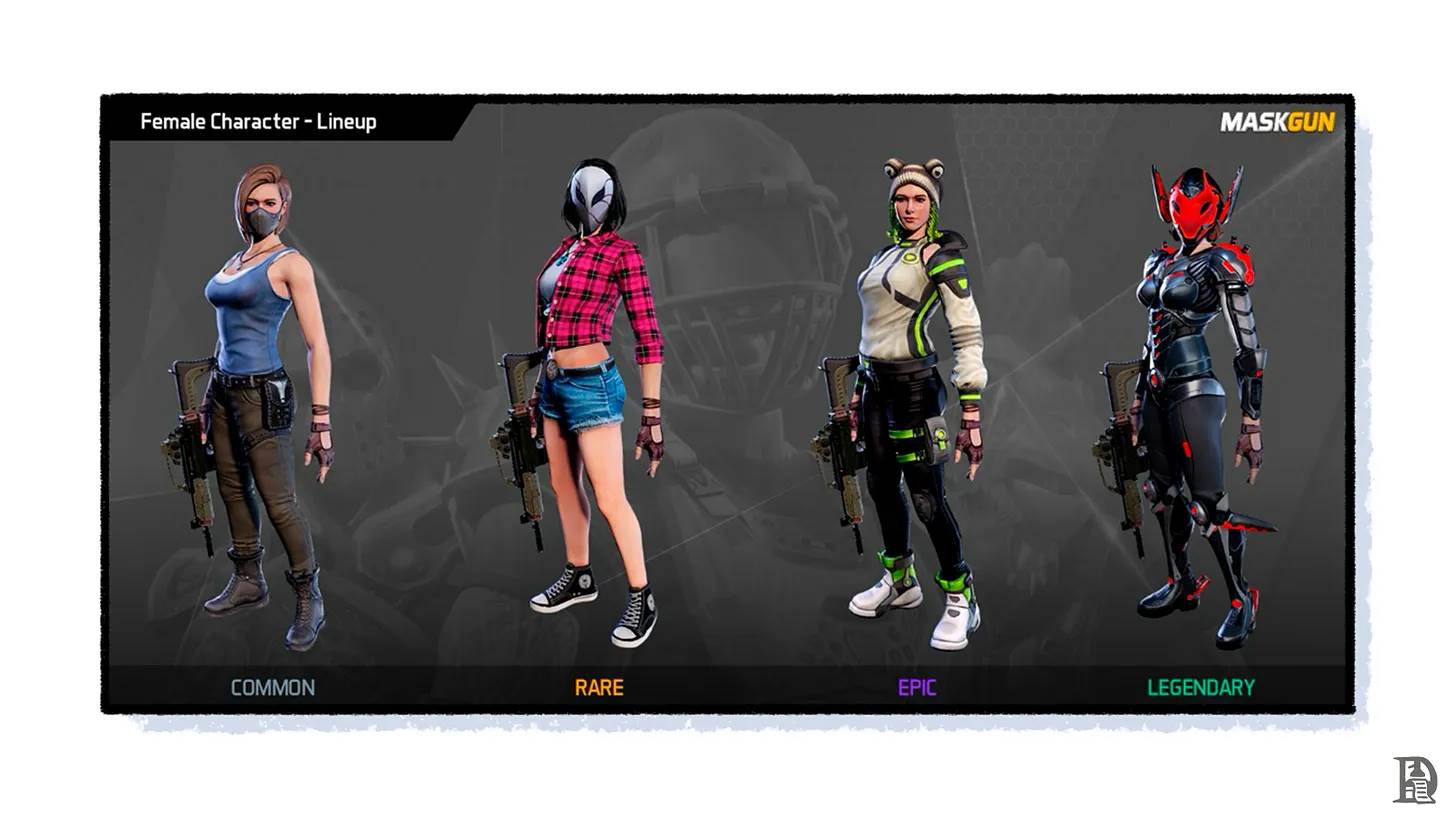
One of the characters with a prosthetic limb was a tribute to an active user of MaskGun.
Some stories were quite touching. For example, when a player contacted Roby to tell him the sad news of their amputation, he quickly implemented a skin in the game that highlighted that user. The initial interest in adding MaskGun stickers to the prosthetic limb led to this conversation.
Roby ensured that users felt seen and heard in the product.
In another example, he reached out to a player who had spent over $2000 and been playing for five years. Roby wanted to sponsor their favorite bicycle. These were usually names that a marketing manager would not consider incentivizing in any form. But Roby's focus was not on coverage or distribution channels.
He focused on building relationships with those who spent the most time in the game.
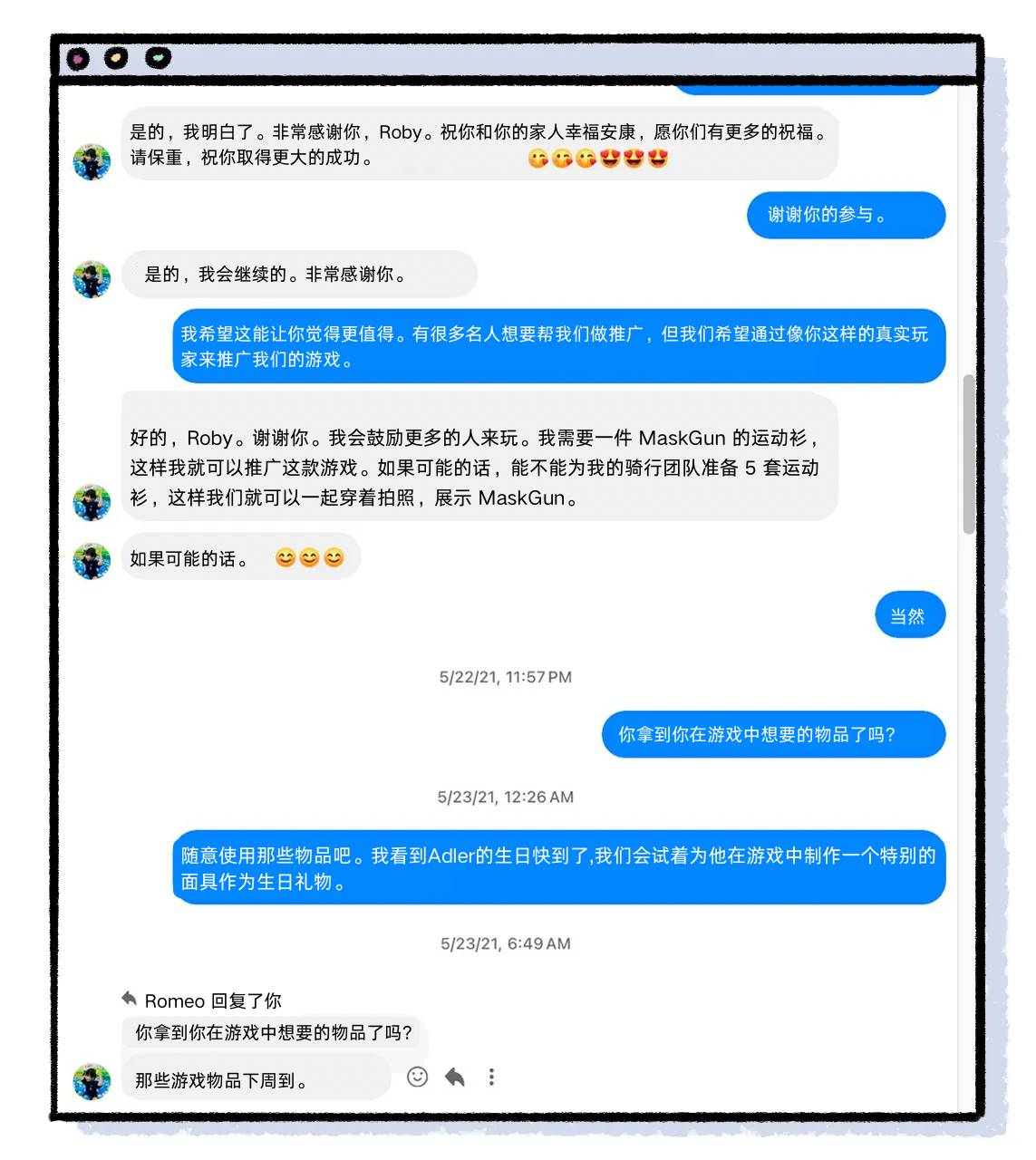
An effective way to build consumer loyalty is to stay in direct contact with the most active users. While this approach may not be scalable, it can have a huge impact on retaining core users. The screenshot above shows one of the conversations Roby had with hundreds of users from his personal Facebook account.
When I was in Roby's office, he showed me his Facebook account. He had almost a decade of private message records with users asking him to quickly fix bugs, requesting to lower their rank in the game, or updating him on their life events. One user even made Roby the legal godfather of their child. These things happened not because a marketing manager spent money on distribution, but because the founder stayed closely connected with the customers. What would lead to a better product? Conversations with excellent venture capitalists (VCs) or interactions with hundreds of users spending time using your product?
This choice was reflected in the product in a unique way. At the time, MaskGun released updates weekly, and Roby created characters in the game that somehow depicted his most active users. When a user contacted him at 3 am, asking for a custom gun skin for their gang in the game, Roby had an "aha moment." The user turned out to be a member of a gang in Australia, and they wanted to express their identity in the game.
Users added their gang's name to their characters in the game and soon wanted to express themselves through clothing representing their characters. These requests led to the creation of an in-game market.

We see ourselves in the art we most commonly interact with. One way to retain users is to reflect the spirit they represent in their product decisions.
The need for self-expression is not limited to games. Often, the products we spend the most time with are those that allow us to express our true selves. Reddit, Instagram, and YouTube all fulfill the human need to be seen and heard. Products like games cannot easily replicate the user base of these social networks. But when the user base is large enough, people want to differentiate or rank themselves.
When developing a product, you can incorporate identity elements in three different forms.
Engage with users, making them feel seen and heard. Invest in their better outcomes. This will help create a critical mass of users.
Provide avenues for self-expression so they can interact with the product in a way that relates to their unique identity.
When there are enough users, provide them with a ranking mechanism for social status and influence.
Our world may have become digital, but humans are still social animals, and the need to be seen, recognized, and ranked persists in the changing times.
How is this reflected in Web3? You can observe this from Dune's emphasis on empowering users. They have a "Wizard" section to highlight their most active users. Similarly, Layer3 also has a leaderboard, where users compete to maintain the highest score while using their products. When users are highlighted through the product, they develop a sense of belonging, which in turn helps retain them.
This also applies to developers. Dan Romero was known for arranging consecutive 15-minute phone calls with developers interested in joining Farcaster. These conversations made the onboarding process to the original protocol more personalized.
Of course, these things cannot be scaled. When the user base reaches billions, the product becomes more impersonal. But another element that can bring users together is culture.
Culture
By 2022, MaskGun had nearly 60 million users. It had been in production for almost eight years, but it still lacked something. The market for shooting games had undergone a huge transformation between PUBG and Fortnite. Roby himself admitted that the product could have gone further in terms of user growth.
A year ago, Roby and a small team of four started talking to users near their office. Within six months, they carefully recorded the opinions of 1000 users. This was a complete mix of college students, people returning home from work, and gamers. Through these conversations, they captured the psyche of the audience they were building for.
A blank canvas was ready, and art needed to be created.
These conversations provided inspiration for the creation of art.
It soon became apparent that, despite being a huge gaming market, there were almost no representatives of users in these games.
In MaskGun, Roby noticed that self-expression helped build a sense of belonging. In NinJump, he noticed the power of intellectual property (IP) in uniting people. In the next chapter, he combined these two ideas, and thus, their flagship game, Indus, was born. It is still in the early testing phase, so I will avoid mentioning the unique aspects of Indus itself or why it could be the next big thing.
What interests me is that Roby began to think about his product from the perspective of intellectual property and self-expression. By combining the two, over time, you form a culture.
Culture is a set of beliefs and expressions that we as a society hold in common. It is not about individuals but about what we do as a collective.
When you send messages to tens of thousands of users individually to join, it is limited. But refining it into culture gives you a scalable system. When Apple aired this ad in 1984, they were transforming into a culture, advocating for the audience to fight against Big Brother or think differently.
One of my favorite examples of a product becoming culture is sneakers. Functionally, all shoes serve the same purpose; they cushion your feet. But by adding decades of manufacturing desire, linking them to the great stories of athletes, and encouraging a parallel market, suddenly, you have sneaker culture. The product transcends its functional service.
So, if you don't have decades to build culture, how do you do it? The answer lies in achieving it through representation and legends.
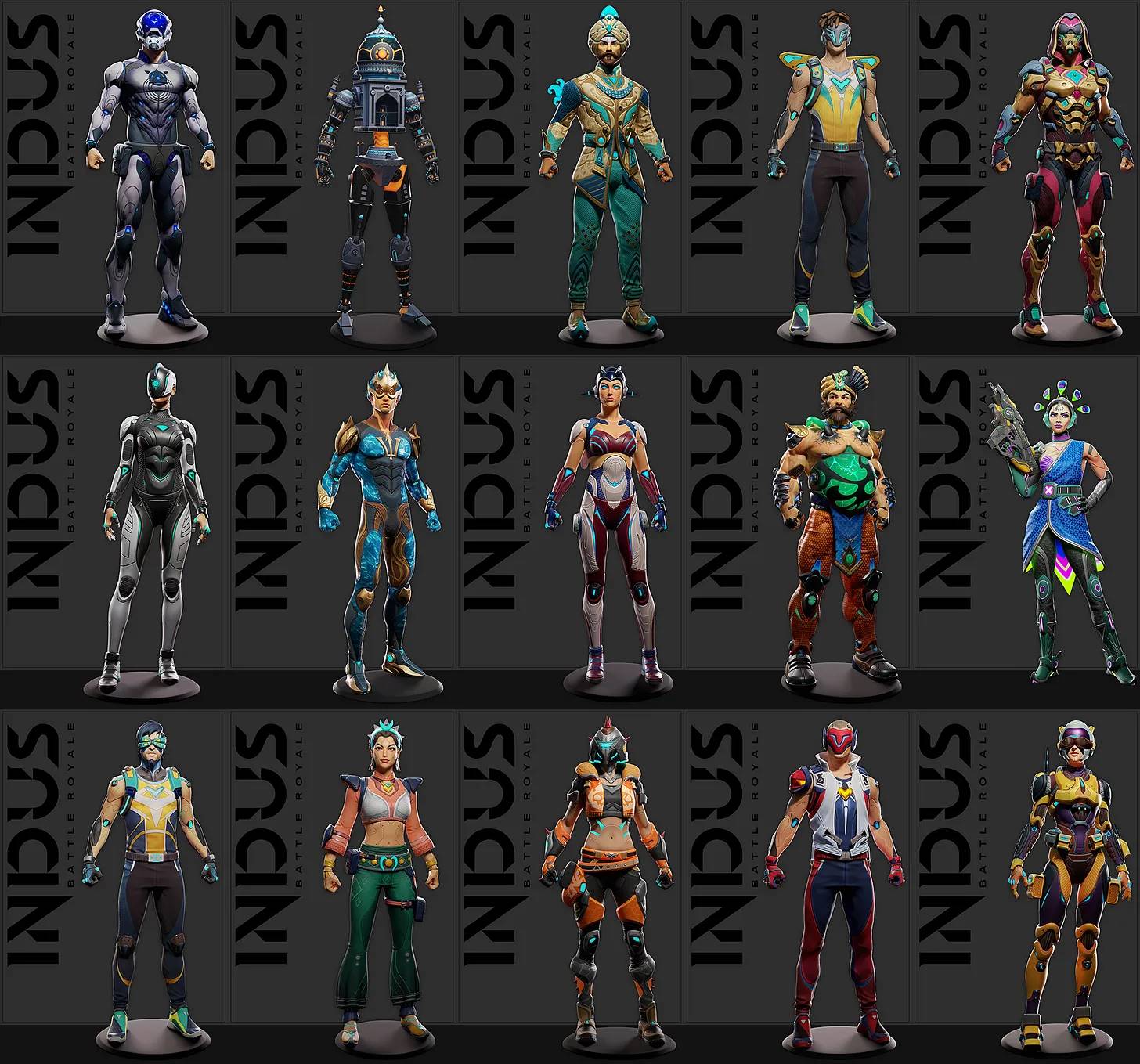
Character renderings from the game Indus under development. Many of these characters are abstract references to Indian local myths and legends.
Indus' current approach to building culture is by showcasing characters and content from India in the game. This could be a double-edged sword. A game that lacks depth but relies solely on representation may not work, but building myths and legends that people can believe in provides room for imagination in understanding the product. Before starting to build the game, the team sat down to think about what Indian futurism might look like.
Through the medium of the game, a vision of the future of India is presented. The characters in the game pay homage to multiple mythological characters, many of whom the players have heard of since childhood.
Subsequently, they combined multiple creator projects to engage the community. In the early stages, most founders build alone in public. Attracting a group of creators to use the product and openly criticize it is akin to building the game in public. In fact, the company regularly hires its top creators to join their team and work in the office. Indus also regularly holds offline events in small towns in India, which are not prioritized for gaming market segmentation.
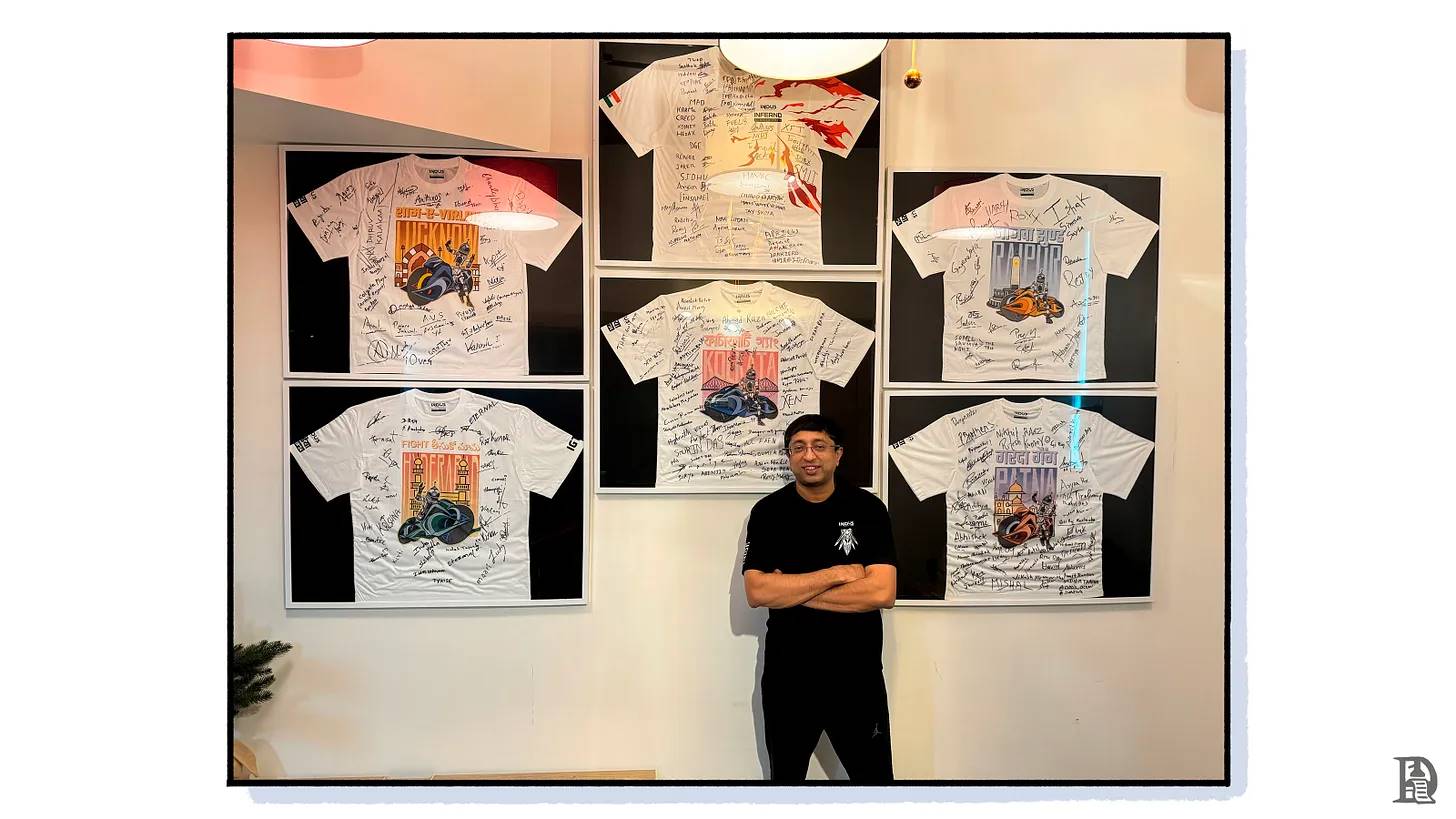
T-shirts with user signatures in a room at the SuperGaming office. Each t-shirt is custom-designed, representing the towns visited by the SuperGaming team in promoting Indus. This made me acutely aware of the studio team's target audience.
When a brand enters an underserved market, it can build lasting loyalty. This strategy helps create distribution channels while collecting crucial user feedback. Naturally, some feedback will be negative. For example, this feedback is a critique of the current flaws in the game.
When building a community, you must accept both criticism and praise. A healthy community can accommodate both.
Indus currently collaborates with many of the region's largest creators. In fact, Techno Gamerz—one of the region's largest video creators—was once a character in their game. The studio focuses on building lasting relationships rather than one-time media buys.
Web3 products attempt to build culture through brand building. Our meetings penetrate the Twitter algorithm for real-life interactions. But we rarely recognize a brand for its culture. The closest we come is perhaps Berachain, which garnered a lot of attention for its noise. At the Token2049 conference in Dubai, they conducted a drone performance and placed ads on taxis.
However, when I consider it from the perspective of a game trying to leave a mark, I begin to understand their strategy.
Creators (or researchers) rarely get an in-depth understanding of how products are built. As a result, the work team goes through fragmented feedback loops, and the motivation of creators is affected. In Web3, it is increasingly evident that paid interactions with creators only occur when financial incentives are involved.
In other words, participants are expected to portray the product (or protocol) in a glamorous way. To make progress, sponsors need more candor. Creators often, undisturbed, produce better work than most marketing managers can patch together. But as an industry, we have not reached that stage yet.
Digital Third Spaces
As I write this story, I realize that the metaverse is not a distant future concept, but already exists in the games we play and the platforms we spend time on. Twitter is a third space, as is Telegram. For some, Uber Eats might be as well. But not all of these platforms can replace the third spaces we used to frequent, or fulfill their former functions.
One of the main reasons for the rise in depression is the lack of a third space. Historically, village squares, coffee houses, or playgrounds were places where we spent our time. As interaction moves online, we need new town squares. Games are increasingly filling this void. Many Super users use their intellectual property for self-expression and identity.
In the simulated world, people use religion and politics as mechanisms of identity. In the digital world, we will use our online presence and the world we spend time in as extensions of our identity.
So, how can founders leverage this? It can be boiled down to four core elements:
Build enough distribution channels through collaborations with well-positioned brands (or creators) in your target niche market, especially if you are a small startup.
Make users feel seen and heard, providing mechanisms for capturing feedback in shorter cycles.
Create culture by following a set of values and reflecting those values in the product.
Today, people are not buying products, but the stories and characters associated with the products. For example, the Bored Apes became popular in 2021 in part due to endorsements from many celebrities. Owning a Bored Ape signifies owning assets similar to Jay Z. By 2024, owning a Bored Ape might mean being in dire straits, as its price has plummeted.
To nurture and propagate stories, you need a community, and this cannot be achieved overnight in an organic way. For Roby, this process took a decade. For some protocols we collaborate with, this process averages 3 to 4 years.
A strong community needs a quality product as a unifier. Users will miss products that are taken down. Think about how we panic when Twitter or WhatsApp malfunctions.
Some of the games in the SuperGaming catalog are sustained because even years after their release, 20 users are still playing them. Whether it's NinJump from 2014 or MaskGun from 2022, Super's focus has always been on iteratively improving quality products. Our observation is that quality products create active communities.
When used correctly, it helps create a flywheel that retains users longer and provides a competitive advantage for the team in building. As of now, the player base of MaskGun has naturally grown to 90 million, and the pre-registration for Indus has reached 12 million. The former has not received any game updates in the past year, yet still sees 50,000 new users registering daily. This is the advantage of a healthy community.
Ultimately, investing in community and cultivating an atmosphere is not just about pleasing people; it's about investing in user retention and consumer feedback in an organic, authentic, and brand-loyal mechanism. When Roby built the community in the early 2010s, it was to organically spread word-of-mouth for his product. Over the course of a decade, he realized that a healthy community facilitates interaction between users.
People come because of the product, but they stay because of other users. The culture driven by the product determines the way users interact. That's why we see vastly different user behaviors on different platforms, whether it's 4chan, TikTok, or Instagram. The part of a founder's job is to steer the culture in the desired direction.
We are all creating worlds through the products we build. Communities make these worlds habitable, making the residents who come here no longer feel lonely.
免责声明:本文章仅代表作者个人观点,不代表本平台的立场和观点。本文章仅供信息分享,不构成对任何人的任何投资建议。用户与作者之间的任何争议,与本平台无关。如网页中刊载的文章或图片涉及侵权,请提供相关的权利证明和身份证明发送邮件到support@aicoin.com,本平台相关工作人员将会进行核查。




